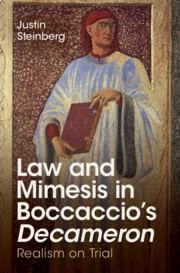Book contents
- Law and Mimesis in Boccaccio’s Decameron
- Law and Mimesis in Boccaccio’s Decameron
- Copyright page
- Contents
- Acknowledgments
- Introduction
- Chapter 1 The Novella on Trial
- Chapter 2 The Artist and the Police
- Chapter 3 The Widow and the Sovereign
- Chapter 4 Torture and the Sense of an Ending
- Chapter 5 Another Way of Possessing
- Chapter 6 The Author on Trial
- Bibliography
- Index
Chapter 6 - The Author on Trial
Published online by Cambridge University Press: 07 August 2023
- Law and Mimesis in Boccaccio’s Decameron
- Law and Mimesis in Boccaccio’s Decameron
- Copyright page
- Contents
- Acknowledgments
- Introduction
- Chapter 1 The Novella on Trial
- Chapter 2 The Artist and the Police
- Chapter 3 The Widow and the Sovereign
- Chapter 4 Torture and the Sense of an Ending
- Chapter 5 Another Way of Possessing
- Chapter 6 The Author on Trial
- Bibliography
- Index
Summary
This concluding chapter turns from inquisitional procedure to the inquisition as an institution. The first part of the chapter examines the tale of the good man and the inquisitor (1.6). The second part argues that when Boccaccio responds to his nameless critics, he puts himself in the role of the good man and treats his critics as inquisitors. In mounting his defense, Boccaccio compares his situation to that of Dante’s; both must contend with the talk of the crowd. Yet instead of transcending common talk, Boccaccio answers it: he parries his critics’ talk, their novelle, with another novella (recounting a tale about a hermit’s son’s sexual awakening). Dante responds to an inquisition against him by ensnaring his judges within a more encompassing inquisitorial trial. Boccaccio turns their monologue into a dialogue, their whispered criticisms into an open rhetorical contest, their secret denunciation into an accusatorial trial.
- Type
- Chapter
- Information
- Law and Mimesis in Boccaccio's DecameronRealism on Trial, pp. 192 - 218Publisher: Cambridge University PressPrint publication year: 2023

